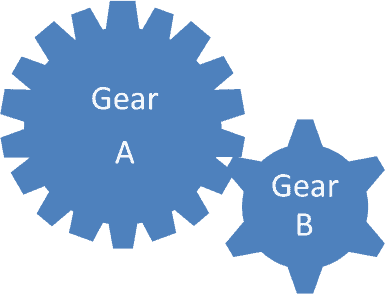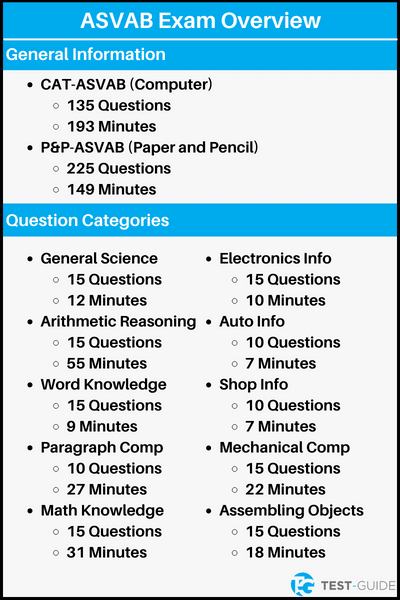

In the figure below, if gear A turns 15 times, how many revolutions will gear B make?

Which figure best shows how the objects in the left box will touch if the letters for each object are matched?
Question 3 of 8A product originally costs $125. If the product goes on sale for 20% off, and then goes on sale for an additional 30% off, what is the price of the product?
A woman has 8 black shoes, 5 brown shoes, 2 red shoes, and 5 boots. What percentage of her collection is boots?
Start preparing for your exam with our ASVAB practice test.
We have included practice exams for each subject tested on the ASVAB. Pick which subject you would like to practice with below!
If you want some additional ASVAB prep, view the resources listed in the table below:
| Resource | Provider |
|---|---|
| ASVAB Sample PDF 1 | TutorMeMath |
| ASVAB Sample PDF 2 | SAHS |
| Official ASVAB Sample Questions | ASVAB |
The ASVAB is a test used by the U.S. Military to help screen and place candidates. The test includes 10 different sections with each section containing a different number of questions and time limit.
You can see the number of questions and time limit below:
| Section | Questions | Time Limit (Minutes) |
|---|---|---|
| General Science (GS) | 15 | 12 |
| Arithmetic Reasoning (AR) | 15 | 55 |
| Word Knowledge (WK) | 15 | 9 |
| Paragraph Comprehension (PC) | 10 | 27 |
| Math Knowledge (MK) | 15 | 31 |
| Electronics Information (EI) | 15 | 10 |
| Auto Information (AI) | 10 | 7 |
| Shop Information (SI) | 10 | 7 |
| Mechanical Comprehension (MC) | 15 | 22 |
| Assembling Objects (AO) | 15 | 18 |
| Total | 135 | 198 |
The table above is for the computer adaptive test (CAT) version of the ASVAB. 70% of applicants end up taking this version of the exam.
Some students may be asked to take the paper and pencil version of the ASVAB. The paper and pencil version tests the same sections and types of questions, but has a different number of questions and time limits.
For more information on the exam and different versions, review our ASVAB exam overview.

Candidates taking the ASVAB are given a AFQT (Armed Forces Qualification Test) score which is a combination of your scores from the following 4 sections:
This AFQT score is represented as a percentile (from 1-99) which depicts how well you scored compared to other test takers.
The scores from the other sections are used to determine which different military jobs could be a good fit for you.
You can read our complete guide to ASVAB scores for more information.
To register for the ASVAB test, you will need to talk to your local recruiter. After talking to your recruiter, and they determine you are qualified, you can schedule your exam.
There are not set dates for taking the exam.
You can take the exam at 3 different locations:
MEPS stands for Military Entrance Processing Station (65 total) and METS stands for Military Entrance Testing Sites (1000’s of these).
Using an ASVAB practice exam before taking the actual exam has many benefits. Some of the most important benefits include:
We recommend following these steps when practicing to get the most benefits and ensure you are prepared.
Taking an initial ASVAB practice test will help you learn where you stand. You may find that you did well on 8 of the subjects but struggled with the other 2.
A diagnostic exam is a great way to help you gauge where you are starting from and track your progress as you continue your studies.
After taking a practice exam, you can narrow down which subjects you struggled with. You can then target your studies on those specific subjects.
It is important to be honest with yourself when targeting your studies. You should focus on the subjects that give you the most trouble first and work your way through those.
As you become more comfortable with the subject, you can move on to the next most difficult subject for yourself.
After completing some targeted studying, take some more ASVAB practice tests. You can compare your scores from these practice exams to your diagnostic exam.
Did you do better? Are the scores on this round of exams matching your expectations?
These are some of the questions you should be asking yourself.
Answer explanations are a great way to learn complex concepts. You will learn how to solve ASVAB specific practice questions and how to solve them in the most time efficient manner.
Even if you already know how to solve a question, an answer explanation may help you figure out how to solve it in a better (quicker) way.
As with any exam, if you do not prepare properly, the exam will be challenging. With that being said, the ASVAB is not the most challenging exam in the world. It will require some preparation, but most students will find it easier than the ACT or SAT.
The amount of time you spend practicing for the ASVAB depends on you as a person. Some students will spend a couple of months preparing while other students may only spend 2 weeks.
It is generally recommended that you spend about 2 months preparing for this exam to ensure you are not cramming your studies right before you take the actual exam.
No, you are not allowed to use calculators at the exam. Your test administrator will provide everything you need, including: pencils (number 2), scratch paper, test booklets, and answer sheets.
You can take the ASVAB as many times as you would like. However, there are some restrictions.
After taking the ASVAB for the first time, you must wait 1 calendar month in order to retake the test.
If you have retaken the ASVAB twice, you will need to wait 6 months between tests.
In order to take the ASVAB for enlistment purposes, you will need to speak with a recruiter and schedule a time to take the test.
If you cannot pass the exam you will not be allowed to enlist in the U.S. Military.
Practice makes perfect. Use our resources above to prepare for the exam.
Many individuals will take the exam at a Military Entrance Processing Station. Some individuals may be able to take the exam through their school or program.
ASVAB stands for armed services vocational aptitude battery. The exam is used to measure your abilities and to predict the success you may have in the military.